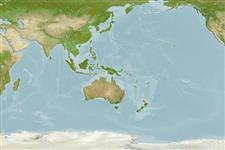Environment: milieu / climate zone / depth range / distribution range
Ecología
marino; salobre asociado a arrecife; rango de profundidad 1 - 30 m (Ref. 34095). Subtropical; 25°S - 38°S
Western Pacific: Queensland to Victoria, Australia.
Tamaño / Peso / Age
Maturity: Lm ? range ? - ? cm
Max length : 15.0 cm TL macho / no sexado; (Ref. 4690)
Espinas dorsales (total) : 15 - 16; Radios blandos dorsales (total) : 7 - 9; Espinas anales: 3; Radios blandos anales: 5; Vértebra: 26 - 27. Presence of a large horizontal spine below the eye, a dorsal fin which originates just behind the posterior edge of the eye, and venomous dorsal spines.
Found in seagrass beds in estuaries (extremely common during reproductive season in the austral Spring) and coastal bays, and sponge gardens on inshore reefs. Venomous dorsal spines often inflict a painful sting to fishers (Ref. 34095, 39597). Of no commercial importance but often entrapped in fishing gears such as trawls and can be dangerous to fishermen who attempt to remove these (Ref. 39597).
Life cycle and mating behavior
Madurez | Reproducción | Puesta | Huevos | Fecundidad | Larva
Paxton, J.R., D.F. Hoese, G.R. Allen and J.E. Hanley, 1989. Pisces. Petromyzontidae to Carangidae. Zoological Catalogue of Australia, Vol. 7. Australian Government Publishing Service, Canberra, 665 p. (Ref. 7300)
IUCN Red List Status (Ref. 130435: Version 2024-1)
Human uses
Herramientas
Special reports
Download XML
Fuentes de Internet
Estimates based on models
Preferred temperature (Ref.
123201): 17.6 - 24.2, mean 20.7 °C (based on 105 cells).
Phylogenetic diversity index (Ref.
82804): PD
50 = 0.6250 [Uniqueness, from 0.5 = low to 2.0 = high].
Bayesian length-weight: a=0.01122 (0.00514 - 0.02450), b=3.04 (2.87 - 3.21), in cm total length, based on all LWR estimates for this body shape (Ref.
93245).
Nivel trófico (Ref.
69278): 3.2 ±0.3 se; based on size and trophs of closest relatives
Resiliencia (Ref.
120179): Medio, población duplicada en un tiempo mínimo de 1.4-4.4 años (Preliminary K or Fecundity.).
Fishing Vulnerability (Ref.
59153): Low vulnerability (10 of 100).
Nutrients (Ref.
124155): Calcium = 51.7 [17.2, 144.7] mg/100g; Iron = 0.661 [0.315, 1.457] mg/100g; Protein = 18.7 [17.1, 20.2] %; Omega3 = 0.348 [0.142, 0.957] g/100g; Selenium = 10.4 [4.3, 25.7] μg/100g; VitaminA = 104 [31, 354] μg/100g; Zinc = 1.37 [0.86, 2.17] mg/100g (wet weight);
